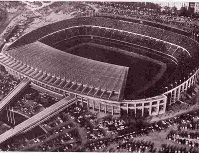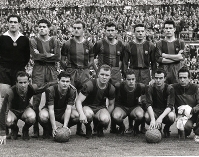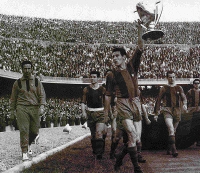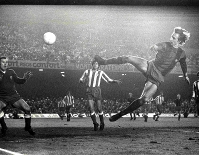From the construction of the Camp Nou to the 75th anniversary (1957-1974)

News article on: History




From the construction of the Camp Nou to the 75th anniversary (1957-1974)
The club came of age with the construction of the Camp Nou stadium. It was an unprecedented project on an architectural level, as well as being extraordinarily ambitious on a financial scale.
But with the team going from strength to strength, there were plenty of reasons to justify the
construction of a new home for the team. However, the earliest years of the stadium bore witness to
one of the club’s most mediocre periods, with very little sporting success.
But the fan base was increasing regardless, in no small part due to the increasingly more
important social significance attached to the club. This was made particularly clear when Narcís de
Carreras became president in 1968, and coined a phrase that has gone on to become something of a
club slogan, ‘More than a club’. FC Barcelona had become associated with some of the
most fervently pro-Catalan and anti-Franco sentiments in Catalonia, and this contributed to making
the club hugely influential in local society, bolstered by an increasingly closer relationship with
the cultural world. After signing Dutch superstar Johan Cruyff, Barça went on to win the league
title in 1973-1974, which happened to coincide with the club’s 75th anniversary, a moment
that brought Barça fans closer than ever, despite the limitations that were still being imposed by
the Franco regime.
The Camp Nou becomes the stage
In the late 1940s it started becoming patently obvious that despite being extended, Les Corts
was simply not big enough for Barça, and the club started investigating the possibility of
purchasing anew site. Francesc Miró-Sans, president from 1953, was one of the driving forces behind
the project, and the Camp Nou was eventually inaugurated on September 24, 1957. The new stadium
could hold 90,000 spectators, including 49,000 club members, and was the new stage for a team that
was promising big things after winning the 1957 Cup final at Montjuïc.
The league championships in 1958-59 and 1959-60 and the Fairs Cup wins in 1957-1958 and
1959-60 were due in no small measure to the presence of legendary coach Helenio Herrera, who had a
host of talented players at his command, including Kocsis, Czibor, Evaristo, Kubala, Eulogio
Martínez, Suárez, Villaverde, Olivella, Gensana, Segarra, Gràcia, Vergés and Tejada. But that
veritable constellation of stars would not carry over into the sixties. The lost European Cup Final
in Berne 1961 set the scene for a disappointing period in which the only major titles Barça won
were the 1963 and 1968 Cups and one more Fairs Cup in 1966.
More than a club
But although successes on the pitch were few and far between, the club’s membership
never stopped growing. One of the biggest attractions of following Barça was its increasing
symbolism as being part of the kind of Catalonia that the Franco regime was so opposed to. Incoming
president Narcís de Carreras made a famous reference to this in his acceptance speech in January
1968, when he proclaimed that “Barça is more than a club”. President Agustí Montal i
Costa (1969-1977) took this a step further, doing his utmost to highlight the club’s Catalan
identity, despite the limits imposed by the Franco dictatorship, and fighting for the cause of
democracy in football, which led him into several high-profile confrontations with Franco’s
sports authorities.
Johan Cruyff arrives
The signing of foreign players had been a controversial issue ever since the Di Stéfano
affair in 1953. In the 1970s Barça suffered from the arbitrary nature of the sports authorities,
such as in determining the status of foreigners with Spanish parents. But the go-ahead was finally
given for Cruyff to join the club and he made his debut on October 28, 1973. The Dutchman made an
immediate impact as Barça stormed to the league title. The most memorable night of all was an
emphatic 5-0 win away to Real Madrid, Barça fielding a powerful attacking quintet of Rexach,
Asensi, Cruyff, Sotil and Marcial. Cruyff was one of a new generation of players, a natural leader
both on and off the pitch, and attracting massive media interest.
The 75th anniversary
The club’s social identity hit its euphoric height when the 1973-74 league championship
coincided with the 75th anniversary in Autumn 1974. With an avant-garde poster designed by painter
Joan Miró, the celebrations were a very public demonstration of what Barça meant to the people at
the time, involving the participation of artists, writers, singers and other figures representing
the most dynamic aspects of Catalan society. It was on occasion of that anniversary that the song
'Cant del Barça' was recorded by the Sant Jordi Choir, and which has gone on to become the
club’s official anthem.
FC Barcelona History
More than a Club
Corporate information
Official sponsors
Copyright - FCBarcelona | Legal Terms | Buy tickets FC Barcelona | This is the FC Barcelona official website

